公众号后台回复关键字:Pytorch,获取项目github地址。
Pytorch的层次结构从低到高可以分成如下五层。
最底层为硬件层,Pytorch支持CPU、GPU加入计算资源池。
第二层为C++实现的内核。
第三层为Python实现的操作符,提供了封装C++内核的低级API指令,主要包括各种张量操作算子、自动微分、变量管理. 如torch.tensor,torch.cat,torch.autograd.grad,nn.Module. 如果把模型比作一个房子,那么第三层API就是【模型之砖】。
第四层为Python实现的模型组件,对低级API进行了函数封装,主要包括各种模型层,损失函数,优化器,数据管道等等。如torch.nn.Linear,torch.nn.BCE,torch.optim.Adam,torch.utils.data.DataLoader. 如果把模型比作一个房子,那么第四层API就是【模型之墙】。
第五层为Python实现的模型接口。Pytorch没有官方的高阶API。为了便于训练模型,作者仿照keras中的模型接口,使用了不到300行代码,封装了Pytorch的高阶模型接口torchkeras.Model。如果把模型比作一个房子,那么第五层API就是模型本身,即【模型之屋】。
我们将以线性回归和DNN二分类模型为例,直观对比展示在不同层级实现模型的特点。
下面的范例使用Pytorch的中阶API实现线性回归模型和和DNN二分类模型。
Pytorch的中阶API主要包括各种模型层,损失函数,优化器,数据管道等等。
import os
import datetime
#打印时间
def printbar():
nowtime = datetime.datetime.now().strftime('%Y-%m-%d %H:%M:%S')
print("\n"+"=========="*8 + "%s"%nowtime)
#mac系统上pytorch和matplotlib在jupyter中同时跑需要更改环境变量
os.environ["KMP_DUPLICATE_LIB_OK"]="TRUE"
一,线性回归模型
1,准备数据
import numpy as np
import pandas as pd
from matplotlib import pyplot as plt
import torch
from torch import nn
import torch.nn.functional as F
from torch.utils.data import Dataset,DataLoader,TensorDataset
#样本数量
n = 400
# 生成测试用数据集
X = 10*torch.rand([n,2])-5.0 #torch.rand是均匀分布
w0 = torch.tensor([[2.0],[-3.0]])
b0 = torch.tensor([[10.0]])
Y = X@w0 + b0 + torch.normal( 0.0,2.0,size = [n,1]) # @表示矩阵乘法,增加正态扰动
# 数据可视化
%matplotlib inline
%config InlineBackend.figure_format = 'svg'
plt.figure(figsize = (12,5))
ax1 = plt.subplot(121)
ax1.scatter(X[:,0],Y[:,0], c = "b",label = "samples")
ax1.legend()
plt.xlabel("x1")
plt.ylabel("y",rotation = 0)
ax2 = plt.subplot(122)
ax2.scatter(X[:,1],Y[:,0], c = "g",label = "samples")
ax2.legend()
plt.xlabel("x2")
plt.ylabel("y",rotation = 0)
plt.show()
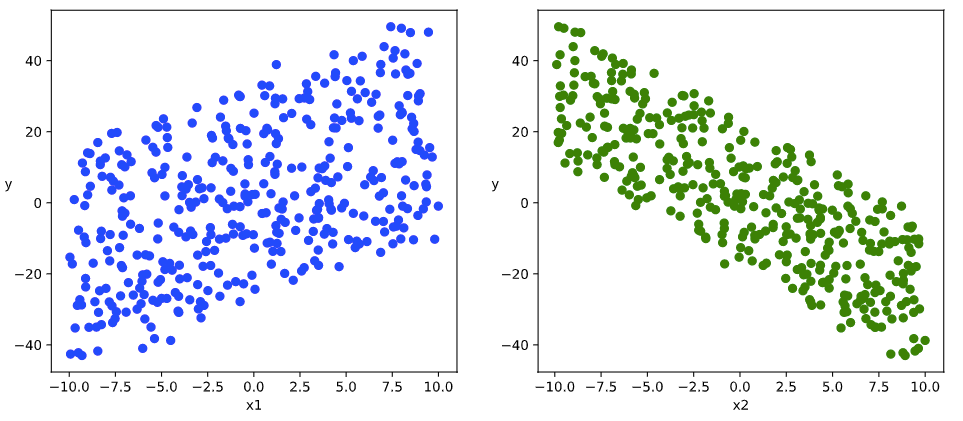
#构建输入数据管道
ds = TensorDataset(X,Y)
dl = DataLoader(ds,batch_size = 10,shuffle=True,num_workers=2)
2,定义模型
model = nn.Linear(2,1) #线性层
model.loss_func = nn.MSELoss()
model.optimizer = torch.optim.SGD(model.parameters(),lr = 0.01)
3,训练模型
def train_step(model, features, labels):
predictions = model(features)
loss = model.loss_func(predictions,labels)
loss.backward()
model.optimizer.step()
model.optimizer.zero_grad()
return loss.item()
# 测试train_step效果
features,labels = next(iter(dl))
train_step(model,features,labels)
269.98016357421875
def train_model(model,epochs):
for epoch in range(1,epochs+1):
for features, labels in dl:
loss = train_step(model,features,labels)
if epoch%50==0:
printbar()
w = model.state_dict()["weight"]
b = model.state_dict()["bias"]
print("epoch =",epoch,"loss = ",loss)
print("w =",w)
print("b =",b)
train_model(model,epochs = 200)
================================================================================2020-07-05 22:51:53
epoch = 50 loss = 3.0177409648895264
w = tensor([[ 1.9315, -2.9573]])
b = tensor([9.9625])
================================================================================2020-07-05 22:51:57
epoch = 100 loss = 2.1144354343414307
w = tensor([[ 1.9760, -2.9398]])
b = tensor([9.9428])
================================================================================2020-07-05 22:52:01
epoch = 150 loss = 3.290461778640747
w = tensor([[ 2.1075, -2.9509]])
b = tensor([9.9599])
================================================================================2020-07-05 22:52:06
epoch = 200 loss = 3.047853469848633
w = tensor([[ 2.1134, -2.9306]])
b = tensor([9.9722])
# 结果可视化
%matplotlib inline
%config InlineBackend.figure_format = 'svg'
w,b = model.state_dict()["weight"],model.state_dict()["bias"]
plt.figure(figsize = (12,5))
ax1 = plt.subplot(121)
ax1.scatter(X[:,0],Y[:,0], c = "b",label = "samples")
ax1.plot(X[:,0],w[0,0]*X[:,0]+b[0],"-r",linewidth = 5.0,label = "model")
ax1.legend()
plt.xlabel("x1")
plt.ylabel("y",rotation = 0)
ax2 = plt.subplot(122)
ax2.scatter(X[:,1],Y[:,0], c = "g",label = "samples")
ax2.plot(X[:,1],w[0,1]*X[:,1]+b[0],"-r",linewidth = 5.0,label = "model")
ax2.legend()
plt.xlabel("x2")
plt.ylabel("y",rotation = 0)
plt.show()
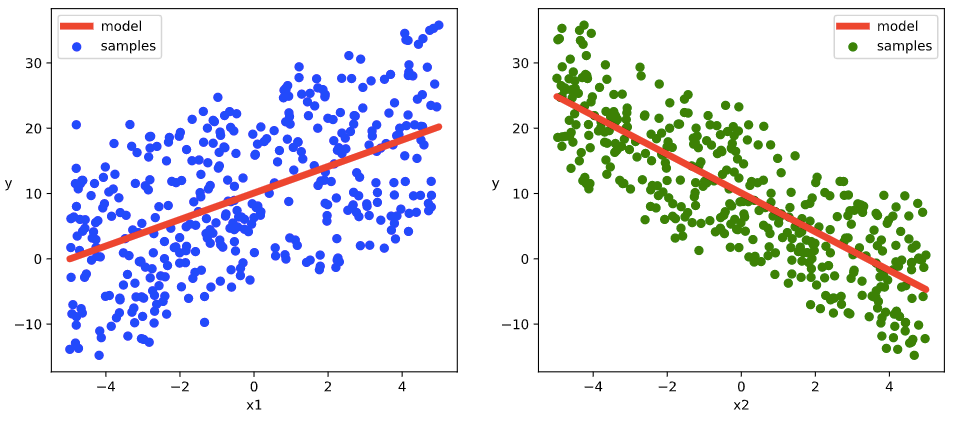
二, DNN二分类模型
1,准备数据
import numpy as np
import pandas as pd
from matplotlib import pyplot as plt
import torch
from torch import nn
import torch.nn.functional as F
from torch.utils.data import Dataset,DataLoader,TensorDataset
%matplotlib inline
%config InlineBackend.figure_format = 'svg'
#正负样本数量
n_positive,n_negative = 2000,2000
#生成正样本, 小圆环分布
r_p = 5.0 + torch.normal(0.0,1.0,size = [n_positive,1])
theta_p = 2*np.pi*torch.rand([n_positive,1])
Xp = torch.cat([r_p*torch.cos(theta_p),r_p*torch.sin(theta_p)],axis = 1)
Yp = torch.ones_like(r_p)
#生成负样本, 大圆环分布
r_n = 8.0 + torch.normal(0.0,1.0,size = [n_negative,1])
theta_n = 2*np.pi*torch.rand([n_negative,1])
Xn = torch.cat([r_n*torch.cos(theta_n),r_n*torch.sin(theta_n)],axis = 1)
Yn = torch.zeros_like(r_n)
#汇总样本
X = torch.cat([Xp,Xn],axis = 0)
Y = torch.cat([Yp,Yn],axis = 0)
#可视化
plt.figure(figsize = (6,6))
plt.scatter(Xp[:,0],Xp[:,1],c = "r")
plt.scatter(Xn[:,0],Xn[:,1],c = "g")
plt.legend(["positive","negative"]);
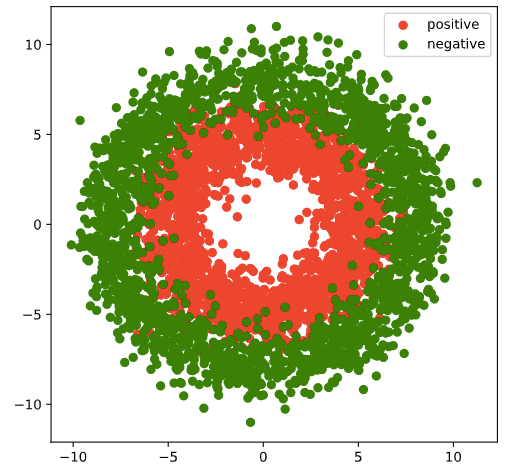
#构建输入数据管道
ds = TensorDataset(X,Y)
dl = DataLoader(ds,batch_size = 10,shuffle=True,num_workers=2)
2, 定义模型
class DNNModel(nn.Module):
def __init__(self):
super(DNNModel, self).__init__()
self.fc1 = nn.Linear(2,4)
self.fc2 = nn.Linear(4,8)
self.fc3 = nn.Linear(8,1)
# 正向传播
def forward(self,x):
x = F.relu(self.fc1(x))
x = F.relu(self.fc2(x))
y = nn.Sigmoid()(self.fc3(x))
return y
# 损失函数
def loss_func(self,y_pred,y_true):
return nn.BCELoss()(y_pred,y_true)
# 评估函数(准确率)
def metric_func(self,y_pred,y_true):
y_pred = torch.where(y_pred>0.5,torch.ones_like(y_pred,dtype = torch.float32),
torch.zeros_like(y_pred,dtype = torch.float32))
acc = torch.mean(1-torch.abs(y_true-y_pred))
return acc
# 优化器
@property
def optimizer(self):
return torch.optim.Adam(self.parameters(),lr = 0.001)
model = DNNModel()
# 测试模型结构
(features,labels) = next(iter(dl))
predictions = model(features)
loss = model.loss_func(predictions,labels)
metric = model.metric_func(predictions,labels)
print("init loss:",loss.item())
print("init metric:",metric.item())
init loss: 0.7065666913986206
init metric: 0.6000000238418579
3,训练模型
def train_step(model, features, labels):
# 正向传播求损失
predictions = model(features)
loss = model.loss_func(predictions,labels)
metric = model.metric_func(predictions,labels)
# 反向传播求梯度
loss.backward()
# 更新模型参数
model.optimizer.step()
model.optimizer.zero_grad()
return loss.item(),metric.item()
# 测试train_step效果
features,labels = next(iter(dl))
train_step(model,features,labels)
(0.6048880815505981, 0.699999988079071)
def train_model(model,epochs):
for epoch in range(1,epochs+1):
loss_list,metric_list = [],[]
for features, labels in dl:
lossi,metrici = train_step(model,features,labels)
loss_list.append(lossi)
metric_list.append(metrici)
loss = np.mean(loss_list)
metric = np.mean(metric_list)
if epoch%100==0:
printbar()
print("epoch =",epoch,"loss = ",loss,"metric = ",metric)
train_model(model,epochs = 300)
================================================================================2020-07-05 22:56:38
epoch = 100 loss = 0.23532892110607917 metric = 0.934749992787838
================================================================================2020-07-05 22:58:18
epoch = 200 loss = 0.24743918558603128 metric = 0.934999993443489
================================================================================2020-07-05 22:59:56
epoch = 300 loss = 0.2936080049697884 metric = 0.931499992609024
# 结果可视化
fig, (ax1,ax2) = plt.subplots(nrows=1,ncols=2,figsize = (12,5))
ax1.scatter(Xp[:,0],Xp[:,1], c="r")
ax1.scatter(Xn[:,0],Xn[:,1],c = "g")
ax1.legend(["positive","negative"]);
ax1.set_title("y_true");
Xp_pred = X[torch.squeeze(model.forward(X)>=0.5)]
Xn_pred = X[torch.squeeze(model.forward(X)<0.5)]
ax2.scatter(Xp_pred[:,0],Xp_pred[:,1],c = "r")
ax2.scatter(Xn_pred[:,0],Xn_pred[:,1],c = "g")
ax2.legend(["positive","negative"]);
ax2.set_title("y_pred");
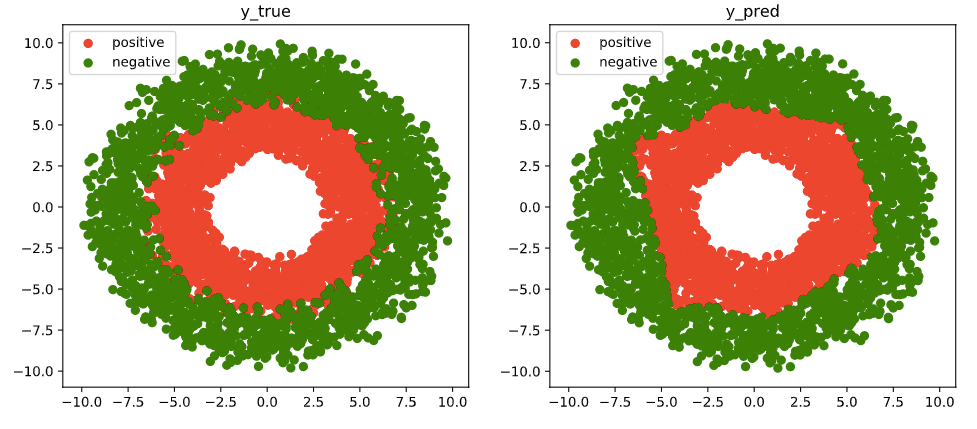
如果本书对你有所帮助,想鼓励一下作者,记得给本项目加一颗星星star⭐️,并分享给你的朋友们喔😊!
如果对本书内容理解上有需要进一步和作者交流的地方,可以在公众号后台回复关键字:加群,加入读者交流群和大家讨论。
公众号后台回复关键字:pytorch,获取项目github地址。
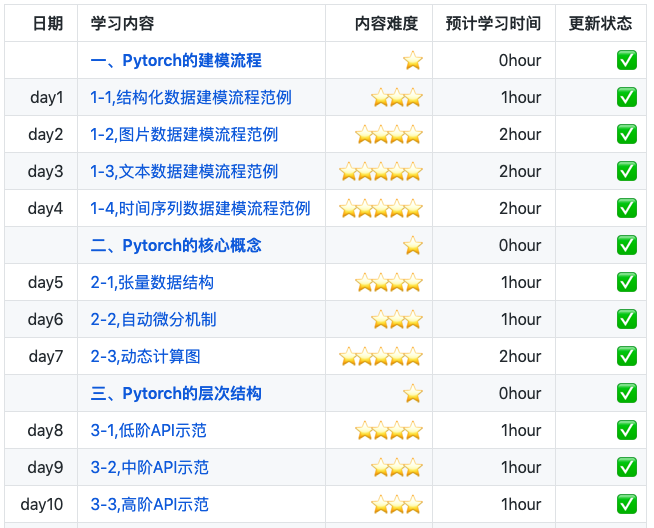


本文分享自微信公众号 - Python与算法之美(Python_Ai_Road)。
如有侵权,请联系 support@oschina.cn 删除。
本文参与“OSC源创计划”,欢迎正在阅读的你也加入,一起分享。
来源:oschina
链接:https://my.oschina.net/u/4592076/blog/4413314